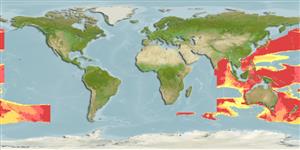Elasmobranchi (squali e razze) (sharks and rays) >
Squaliformes (Sleeper and dogfish sharks) >
Squalidae (Dogfish sharks)
Etymology: Squalus: Genus name from Latin 'squalus' meaning shark (Ref. 6885, 27436); edmundsi: Named for Matt Edmunds, formerly with CSIRO Marine Laboratory in the 1990s..
More on authors: White, Last & Stevens.
Environment: milieu / climate zone / depth range / distribution range
Ecologia
marino; distribuzione batimetrica 204 - 850 m (Ref. 58442), usually 300 - 500 m (Ref. 58442). Tropical
Distribuzione
Stati | Aree FAO | Ecosystems | Presenze | Point map | Introduzioni | Faunafri
Eastern Indian Ocean: Western Australia and Indonesia.
Size / Peso / Age
Maturity: Lm ? range ? - ? cm
Max length : 70.0 cm TL maschio/sesso non determinato; (Ref. 58442); 86.6 cm TL (female)
Short description
Morfologia | Morfometria
This moderate-sized species of the ‘mitsukurii group’ has the following set of characters: moderately elongate body, depth 9.9-11.5% TL; narrowly triangular snout, moderately long, preoral length 2.0-2.44 times the horizontal prenarial length, 10.3-10.8% TL, mouth width 1.56-1.81 (1.73) times the horizontal prenarial length; pre-first dorsal length 27.7-30.0 (28.5)% TL; pre-second dorsal length 60.2-62.9 (61.3)% TL; interdorsal space 23.5-25.6 (24.7)% TL; weakly bifurcated anterior nasal flap; first dorsal fin large, upright, first dorsal-fin height 7.0-8.0% TL; first dorsal-fin spine strong, upright and broad-based; second dorsal-fin spine long, moderately broad-based; prepectoral length 21.9-23.1 (22.6)% TL; pelvic-caudal space 25.0-26.7 (25.9)% TL; pectoral fin of adult individuals not falcate; pectoral-fin inner margin relatively short, 6.4-7.1% TL; caudal bar is oblique, extending along base of lower lobe to caudal fork, less than 0.1-0.2 of posterior margin of upper lobe, upper caudal fringe narrow, with a large dark saddle, distinctly closer to tip of lobe than its base; flank denticles are strongly tricuspidate; monospondylous centra 43-44, precaudal centra 86-91, total centra 1130-120 (Ref. 58442).
Commonly caught by demersal longline fisheries operating in deepwater; utilized for its meat, fins and liver oil which is of high value (Ref. 58048).
Life cycle and mating behavior
Maturità | Riproduzione | Deposizione | Uova | Fecundity | Larve
Distinct pairing with embrace (Ref. 205).
White, W.T., P.R. Last and J.D. Stevens, 2007. Two new species of Squalus of the 'mitsukurii group' from the Indo-Pacific. pp. 71-81. In P.R. Last, W.T. White and J.J. Pogonoski Descriptions of new dogfishes of the genus Squalus (Squaloidea: Squalidae). CSIRO Marine and Atmospheric Research Paper No. 014. 130 pp. (Ref. 58442)
IUCN Red List Status (Ref. 130435)
Threat to humans
Harmless
Human uses
Informazioni ulteriori
Age/SizeAccrescimentoLength-weightLength-lengthLength-frequenciesMorfometriaMorfologiaLarveDinamica popolazioni larvaliReclutamentoAbbondanzaBRUVS
BibliografiaAcquacolturaProfilo di acquacolturaVarietàGeneticaElectrophoresesEreditarietàMalattieElaborazioneNutrientsMass conversion
CollaboratoriImmaginiStamps, Coins Misc.SuoniCiguateraVelocitàModalità di nuotoArea branchialeOtolithsCervelliVista
Strumenti
Special reports
Download XML
Fonti Internet
Estimates based on models
Preferred temperature (Ref.
123201): 6.6 - 13.7, mean 9.9 °C (based on 256 cells).
Phylogenetic diversity index (Ref.
82804): PD
50 = 0.5000 [Uniqueness, from 0.5 = low to 2.0 = high].
Bayesian length-weight: a=0.00339 (0.00162 - 0.00707), b=3.10 (2.93 - 3.27), in cm total length, based on LWR estimates for this Genus-body shape (Ref.
93245).
Trophic level (Ref.
69278): 4.3 ±0.4 se; based on size and trophs of closest relatives
Resilienza (Ref.
120179): Molto basso, tempo minimo di raddoppiamento della popolazione più di 14 anni (Preliminary K or Fecundity.).
Fishing Vulnerability (Ref.
59153): Moderate to high vulnerability (55 of 100).
